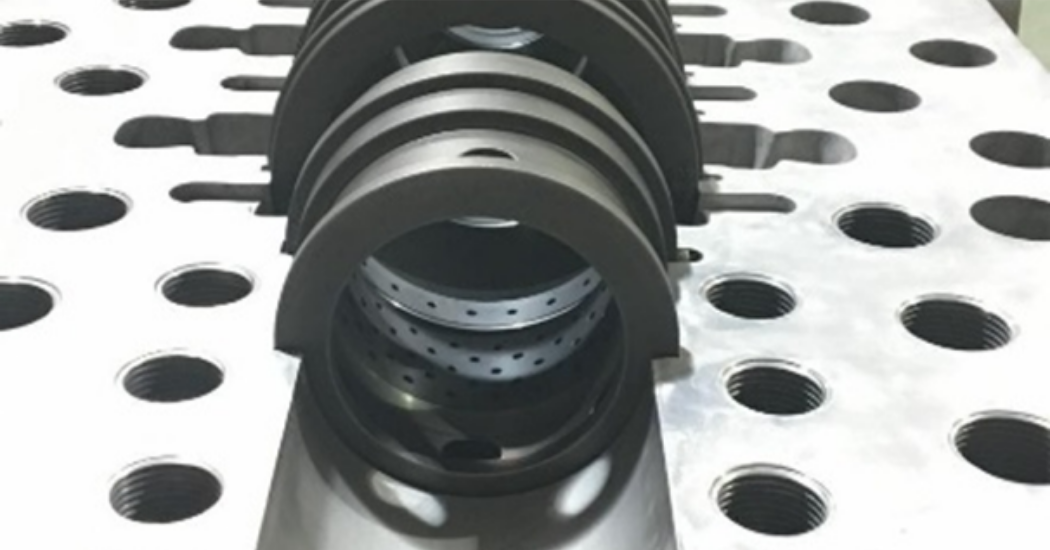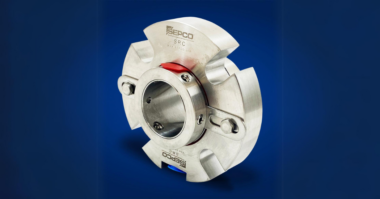The results of an authoritative long-term field study made by a user
For almost 20 years, carbon-filled Perfluoro-Alkoxy (PFA/CF) wear ring materials have been used to upgrade process pumps. These materials are in the Teflon® family but have far more stable thermal stability and wear properties. While both Teflon® and PFA/CR are made by Dupont, the PFA/CF product is known as Vespel™CR-6100 and has made its mark with the assistance of experienced mechanical engineers at Boulden Company.
However, it took eight years of diligent data-taking to infer, with full confidence, the life expectancy of Vespel™ CR-6100 wear rings. Thanks to a long-term efficiency study performed by a competent user (Table 1), a comparison with metallic wear rings now expands our knowledge even more.
Due to the location of the user’s operations, their facility is charged higher-than-average power prices. Most of their pumps are horizontal multi-stage API Type BB3 pumps in refined hydrocarbon service and many of the pumped fluids are flashing, light, low viscosity products. The pumps tend to be quite large, ranging from 500 kW (670 hp) to 2 MW (2,700 hp). Because of the high operating costs, the user routinely conducts tests to track pump efficiency over time.
Other wear ring materials in the study. The user site had collected efficiency data on three different material pairings for their pump wear rings:
- Cast Iron vs 420 SS–the original pump design from the 1980s
- NiCr hard-coated rotating and stationary rings–1990’s upgrades
- Vespel® CR-6100 vs. 420 SS wear rings–current upgrades
The long-term findings in Table 1 track the efficiency over 8 years for the different material combinations, averaging the results from dozens of pumps running each material combination. It summarizes data comparing the recorded efficiencies to the baseline efficiency of a pump using metal parts with API standard clearance.
Pumps using Vespel® CR-6100 started operation with wear ring clearance reduced by 50% compared to the pumps with metal wear parts. For horizontal multi-stage pumps, the observed efficiency improvement attributable to a 50% reduction in clearance provided an average initial efficiency gain of about 4%; this explains why the baseline efficiencies of pumps with Vespel® CR-6100 wear parts are higher.
Table 1: Efficiency trend of Vespel®CR-6100 wear rings compared to baseline efficiency at API standard clearance
| Material Combination/Pairing | Baseline
Efficiency |
Efficiency
After 4 years |
Efficiency
After 8 Years |
| Cast Iron vs. 420 SS | 0% | -3.7% | -5.3% |
| NiCr hard-coated wear rings | 0% | -1.4% | -2.4% |
| Vespel® CR-6100 vs 420 SS | +4% | +2.4% | +1.1% |
Leading up to 2019, eight years of collected data showed that the amount of wear of the Vespel® CR-6100 parts was in line with the hard-coated wear rings. Both Vespel® CR-6100 and hard-coated wear rings showed significantly less wear than cast iron wear rings.
Life Cycle Cost Calculation
From an examination of the life cycle cost for each material pair or combination, it became evident that Vespel® CR-6100 was an excellent investment in the horizontal multi-stage pumps at this user plant. Assuming a typical industrial power price of $0.06/kWh, full-time operation, and a pump power consumption of 1MW (1,340 hp), we find the following 8-year operating costs compared to baseline efficiency:
Cast Iron: -$156,000; referring to additional operating costs over 8 years
NiCr hard-coating: -$60,000; referring to additional operating costs over 8 years
Vespel® CR-6100: $106,000; anticipated cost savings over 8 years
Seven Rules for Using DuPont™ Vespel® CR-6100
The Boulden Company has proactively condensed their many application bulletins into a seven-item list of guidelines for pumps which they (or the user) can apply to just about any fluid machine. Following these seven rules gives user-purchasers confidence that they are using Vespel® CR-6100 properly and thereby improve pump reliability without compromise.
- Stay below the temperature limit of 260 deg. C (500 deg. F)
- Use PFA/CF only in stationary parts, mounted in compression
- Use the PERF-Seal™ design for throttle and center bushings of multi-stage pumps (See Bibliography)
- Install PERF-Seal™ component against a fixed shoulder to ensure it cannot be dislodged by differential pressure
- Avoid extremely abrasive services such as slurries, bottoms, or slops
- Verify that press-fit, clearance, and axial length of part comply with the Boulden Installation Guide
- Ascertain that the pump rotor turns freely when the pump is assembled and ready for commissioning
The study results reconfirmed that PFA/CF materials are among the most valuable and immediately beneficial fluid machinery upgrades. Working with competent suppliers, equipment OEMs and fluid machinery rebuilders benefit all parties involved in upgrading with PFA/CF components.
Always look at the payback achieved. The demonstrated rapid paybacks quickly make up for the higher initial cost of Vespel®CR-6100. Power savings are significant in many pumping services. In long, flexible shafts, and if wear rings are used in conjunction with the PERF-Seal® design, the resulting benefits will be even higher. Moreover, the benefits will also last beyond eight years.
Bibliography
- Aronen, R., and Russek, M., 2011, “Evaluating the Long-Term Performance of Composite Wear Rings”, Proceedings of the 27th International Pump Users Symposium, Turbomachinery Laboratory, Texas A&M University, College Station, Texas
- Aronen, R., Plaizier, D., and Sinclair, D., “Building a Better Boiler Feed Pump,” Pumps and Systems, November 2007
- Aronen, R., and Bothum, L., “Upgraded Boiler Feedwater Pump Improves Efficiency and adds Flexibility,” POWER, September 2017
Acknowledgment
Much of this material was contributed by Robert Aronen (Boulden Company Conshohocken, PA, and Ellange, Luxembourg) for inclusion in a book by Heinz Bloch: “Fluid Machinery: Life Extension of Pumps, Gas Compressors and Drivers,” (Spring 2020), De Gruyter Publishing, Berlin/Germany, ISBN 978-3-11-067413-2
Heinz P. Bloch resides in Montgomery, Texas. He received B.S. and M.S. degrees (cum laude) in Mechanical Engineering from NCE, Newark College of Engineering in 1962/64. He is an ASME Life Fellow and holds lifetime registration as a Professional Engineer in New Jersey. He is one of 10 inaugural inductees into NCE’s Hall of Fame, which honors its most distinguished alumni.





Comments